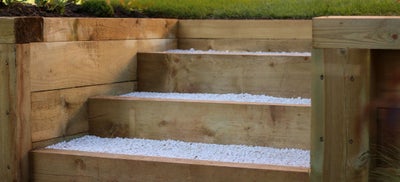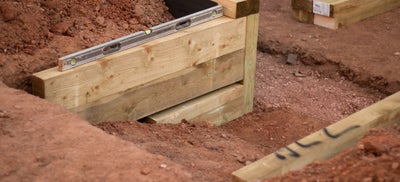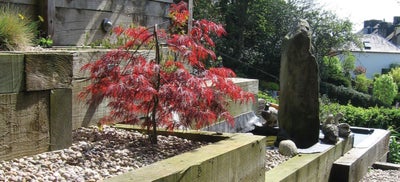Once you have your design and materials ready, you can begin preparing your build area. We think it’s a good idea to mark out the entire space for your steps using marking paint or a chalk measuring out tool along with wooden stakes for accurate levels.
If you’re laying a sleeper length in place as a simple step, it’s not always necessary to submerge the timber, however, for two or more steps you should dig suitable trenches to support your build.
Depending on the height of your steps, you may choose to set the first frame in a concrete footing.
Depending on how many steps you’re building, you should excavate a shallow trench at a time, laying each frame for a bespoke fit. You may either choose to excavate soil at either side of your step so the sides of your frame slot into the earth; or use your shovel to excavate the soil, shaping rough stairs that the frames will then sit on.
Whether you’re building simple steps or a rising frame of stairs, you’ll need to cut your sleepers to size. Ensure you are wearing protective workwear, then measure, mark and scribe each sleeper with a quick square before cutting to size with your circular saw. For any unreachable centre sections that your saw can’t reach, you can use a universal handsaw. If you’re building curved steps, you’ll need to measure and cut the side lengths, so they are bespoke to your space.
To join the step frames you’ll need to create a U shape, securing two of the right-angled corners with at least two timber fixings. We recommend using heavy-duty exterior timber screws for garden landscaping. Make sure you choose fixings that are approximately a 1/3 longer than the depth of your sleepers, so they sufficiently enter the join for a secure hold. If you choose to work with hardwood sleepers you will need to pilot each fixing hole first and use stainless steel timber screws to avoid natural tannin corrosion.
For added protection against rot and decay, we recommend generously brushing cut ends and untreated timber with wood preserver before leaving to dry.






